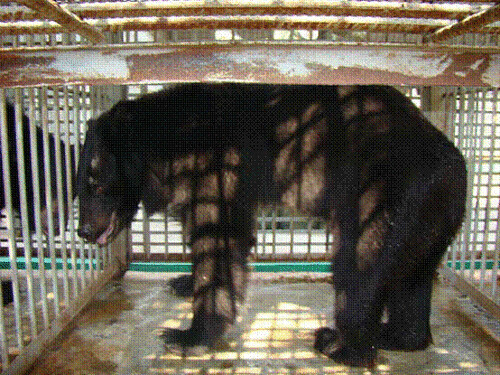中國大陸為主要來源國
在跨區域調查中發現,最常見的貨源來自中國大陸(請見圖示的交易流向):在柬埔寨、寮國、馬來西亞、新加坡、泰國的國外來源產品中,有70~100%都來自中國大陸。姑且不論中國針對其國內使用熊膽藥品相關之法律為何,當這些產品擴散至其他國家就是違法。為了避免這些產品非法流向他國市場,熊膽製造公司必須被更嚴格管制,在邊境檢查點也必須提高警覺。
偏好野生產品並將養殖熊作為保育工具
和先前的研究結論一致,我們研究結果指出,熊養殖場及其熊膽產品之生產,幾乎無法減少野生族群的壓力(Dang 2007, Robinson et al. 2007, Burbach 2009)。
越南胡志明市某養殖場的狹小圈養空間
儘管在中國大陸、日本、南韓、寮國、緬甸、越南這些國家都有熊養殖場,不論是合法或非法經營的,野生的熊產品還是比飼養的受歡迎。以南韓為例,即便養殖場已很普及,使用傳統藥材的醫生還是常有機會可採購俄羅斯的野生熊膽。從我們的調查看來,似乎普遍仍存在購買野生熊製品的偏好,消買者也願意為它們付出更多錢。既然重點是放在野生產製品,而不管這偽裝永續的選項,那麼熊養殖場對於降低野生熊產製品的需求似乎並無太大效果。而且,我們的研究指出,儲備養殖場經常有獵補的野生熊,這跟那些倡導熊的養殖可作為保育措施的人的主張明顯互相抵觸。
雖然還有許多複雜的議題待解決,仍有一些合理的方案可減輕非法貿易,最終保護亞洲地區的熊。本研究建議如下:
•傳統藥材市場銷售非法的熊體製品及其衍生製品應處以罰責,非法產製品應予以沒入充公。
•需要更有效的執法,這涉及各國政府攜手努力,例如東協野生物執法網路(Association of Southeast Asian Nations Wildlife Enforcement Effort,ASEAN-WEN)以及國際打擊野生物犯罪聯盟(International Consortium on Combating Wildlife Crime,ICCWC,結合了CITES秘書處、國際刑警組織、聯合國毒品及犯罪辦事處、世界海關組織與世界銀行)夥伴成員。
•每個國家的權責單位應勒令永久關閉非法熊養殖場。對於熊無法被立即遷離的那些設施,則應在政府、國際及民間專家聯合下密切監管,以確保不會繼續取得熊膽、不會購入新的熊,以及養殖場不會成為非法貿易的來源。
•為使各國善盡責任,TRAFFIC建議和熊相關的所有案件,應透過集中的資料庫跨國追蹤並呈報,以監管並分析貿易趨勢。
※本文翻譯自International Bear News August 2011, vol. 20 no. 3, p 10-12:What Should be Done to Stem the Bear Bile Trade in Asia? Highlights from TRAFFIC’s Recent Investigation (2010–2011)。TRAFFIC為野生物貿易研究委員會(http://www.traffic.org/overview/)。
參考文獻
Burbach, S. 2009. The Asiatic black bear caged for its bile. Traversing the Orient Magazine. http:www.ttoasia. net/theasiatic-black-bear-caged-for-its-bile/.
Dang, N.X. 2007. Bear parts trade in Vietnam and measures for its control. Pages 61–66 in D. Williamson (editor), Proceed- ings of the Fourth International Symposium on the Trade in Bear Parts. TRAFFIC East Asia, Japan.
Garshelis, D.L and R. Steinmetz. 2005. Issues and conservation priorities from the Asiatic black bear expert team. Interna- tional Bear News 14(2):9-12.
Garshelis, D.L. and R. Steinmetz. 2008. Ursus thibetanus. IUCN Red List of Threatened Species Version 2010.4.www.iucnredlist.org.
Foley, K.E., C.J. Stengel, and C.R. Shepherd. 2011. Pills, powders, vials and flakes: The bears bile trade in Asia. TRAFFIC Southeast Asia, Petaling Jaya, Selangor, Malaysia.
Kemf, E., A. Wilson, and C. Servheen. 1999. Wanted alive! Bears in the wild – A WWF Species Status Report. World Wide Fund for Nature, Gland, Switzerland.
Shepherd, C. R. 2007. Bear trade in Southeast Asia: The status of protection for Southeast Asia’s bears. Pages 22–26 in D. Williamson (editor), Proceedings of the Fourth International Symposium on Trade of Bear Parts. TRAFFIC East Asia, Japan.
Robinson, J., G. Cochrane, and K. Loeffler. 2007. Discussion regarding the impacts of bear bile farming on wild bears in China and Viet Nam. Pages 67−73 in D. Williamson (editor), Proceedings of the Fourth International Symposium on the Trade in Bear Parts. TRAFFIC East Asia, Japan.
Williamson, D. 2007. Proceedings of the Fourth International Syposium on the Trade in Bear Parts. TRAFFIC East Asia, Japan.






